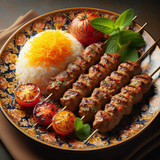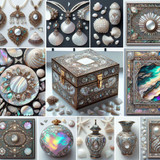Turquoise inlay , Persian handicrafts , Persian decorative
Turquoise inlay
The turquoise is ancient, yet again and again it finds itself back in fashion. Its shining sky blue is one of the most popular trend colors in the world of jewelry and fashion.
Turquoise fixing is one of the branches of handicraft which holds
the beauty and attraction of a good handicraft product. It is believed
that the antiquity of this industry goes back to about seventy years
ago. At that time a Yousef Hakiman known as Mohammadreza started the
craft of turquoise fixing on jewelry in Mashhad and about twenty years
after that this craft was brought to Isfahan by another craftsman named
Hadjdadash and today he is continuing the job in Isfahan.
Turquoise
fixed product are generally constructed of jewelries and containers made
of metals such as copper, brass, silver, nickel silver or bronze on
which small pieces of turquoise stones are placed side by side with
special glue which gives specific beauty to the object.
Turquoise fixing consists of two general stages:
A.
Goldsmith's trade: it is the construction and preparation of the
desired object by one of the above- mentioned metals. This is done by
the goldsmith or metalworkers by hand, press or both . After making the
general frame of the object whether it is a container or jewelry, the
part that should be turquoise fixed is marked and a thin wire of the
same metal is used and soldered to specify the boundary which is common
expression is called "carving" .
B. Turquoise fixing: The
desired turquoise in this art is of "soft" type which is accompanied
with amounts of dirt and stone fragments, which should be separated from
the stone. The turquoise small pieces are then grouped according to
their color and size.
In the next stage the desired object is heated and a layer of "walnut shellac" powder is sprayed on it. The shellac powder is almost melted and covers the surface of the work piece which is sticky, soft and in a melting state.
The turquoise stones which are already prepared are placed on the work piece. The pieces of stone should be placed near each other in a way that there shall be the least space between them. After this stage the product is ready and is abraded by special devices and finishing is performed on it to make it ready for the market.
The important point for the quality of turquoise fixing is the proper installation of the turquoise on the surface of the metal so that it is secured and when finishing operation is performed, the pieces do get loose or separated from the work piece. The second important point is that the more the turquoise container is decorated with turquoise pieces and the more the pieces are arranged in an orderly manner with less space among them with the symmetry of the sub-base as well as beauty and care and attention of the craftsman in polishing and finishing, the more its art value and quality will be.
Turquoise inlay is a common handcraft in Isfahan. In the process of inlaying turquoise the given container is heated and during heating nut lacquer is sprayed on the parts on which turquoises are supposed to be laid . sand paper is used to polish and varnish lacquer coated parts. Later turquoise-inlaid-parts are polished using olive or sesame oil to make it glossy.
In many cultures of the Old and New Worlds, this turquoise has been esteemed for thousands of years as a holy stone, a bringer of good fortune or a talisman. It really does have the right to be called a 'gemstone of the peoples !
Recent Posts
-
Exploring the Timeless Delight of Traditional Chelo Kabab: A Popular Persian Dish
Exploring the Timeless Delight of Traditional Chelo Kabab: A Popular Persian Dish Introduction: …7th Apr 2024 -
Mother of Pearl: A Timeless Elegance in Handicrafts
Mother of Pearl: A Timeless Elegance in HandicraftsMother of Pearl, also known as nacre, has long be …6th Apr 2024 -
Exploring the Rich Flavors of Traditional Chicken Makbous – A Popular Arab Rice Dish
Exploring the Rich Flavors of Traditional Chicken Makbous – A Popular Arab Rice Dish Introducti …6th Apr 2024



